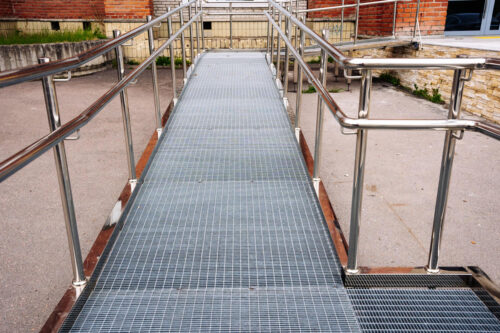The Importance of Weight Capacity in Wheelchair Ramps: A Comprehensive Guide for Commercial and Residential Use

Weight capacity is a crucial factor to consider when investing in a wheelchair ramp system for your residential or commercial property. By ensuring your ramp is capable of supporting the weight of its users and their equipment, you can provide a safe and accessible environment for individuals with mobility impairments.
As a leading provider of rental, sales, and installation of wheelchair ramps in the Ottawa area, we understand the importance of selecting the appropriate weight capacity for your ramp solution. In this blog post, we will discuss the significance of weight capacity, factors influencing weight capacity, and considerations for choosing the right ramp system to accommodate the diverse needs of wheelchair users.
Factors Influencing Ramp Weight Capacity
To make informed choices when selecting wheelchair ramps, it is crucial to understand the factors that influence a ramp’s weight capacity. Here are some significant aspects to consider:
- Ramp Material: The choice of ramp material significantly affects its weight capacity, durability, and maintenance requirements. Aluminum, galvanized steel, and wood are common materials used to construct wheelchair ramps, each offering different weight capacity capabilities. Aluminum and steel ramps typically provide higher weight capacities and better corrosion resistance than traditional wooden ramps.
- Ramp Length: The length of a ramp can impact its weight capacity, with shorter ramps generally offering higher capacities. For longer ramps, structural reinforcements may be necessary to maintain a consistent weight capacity.
- Structural Reinforcements: Reinforcing the structure of a wheelchair ramp can increase weight capacity, ensuring safe use for individuals with mobility devices. Such reinforcements might include additional support beams, cross-bracings, or decking designs that distribute weight more evenly.
- Ramp System Design: Modular and portable ramps offer various design benefits, such as customizable configurations and adjustable weight capacities. Depending on the needs of the user and location, selecting a suitable ramp design can significantly impact weight capacity and overall accessibility.
Choosing the Right Weight Capacity for Your Needs
Accurately determining the appropriate weight capacity for a residential or commercial wheelchair ramp is essential to ensure safe usage and long-term durability. Consider the following steps when selecting the right ramp system for your needs:
- Assess Users’ Weight: Gauge the approximate weight requirements of your ramp users, including their mobility devices and any additional equipment they might need. This will provide a starting point in determining a suitable weight capacity.
- Consider Equipment Requirements: Account for potential equipment, such as medical devices or delivery carts, utilized within your residential or commercial space. Ensuring your ramp system is capable of safely carrying these loads is crucial for both accessibility and preventing structural issues.
- Decide on Appropriate Safety Margin: To account for any unforeseen weight requirements or changes over time, consider selecting a ramp with a weight capacity higher than the combined weight of users and equipment. This safety cushion can offer increased peace of mind and help future-proof your accessibility solutions.
- Consult a Professional: Working with a professional installer, like those on our team, ensures that your ramp system meets the necessary standards and caters to your specific needs. Expert guidance can help you navigate the complexities of weight capacities and provide invaluable insight into potential issues or opportunities.
Additional Considerations for Commercial Spaces
For commercial properties, businesses must ensure that their wheelchair ramps follow legal regulations such as the Accessibility for Ontarians with Disabilities Act (AODA) or the Americans with Disabilities Act (ADA). Additionally, commercial spaces should consider the following:
- Higher Traffic Volume: Commercial properties typically experience higher levels of foot traffic, meaning more individuals with varying mobility devices potentially utilizing the ramp. In turn, this requires a higher weight capacity to accommodate a broader range of users.
- Liability Concerns: Failing to provide adequate and safe accessibility solutions may result in businesses facing liability for accidents or injuries caused by an inadequate ramp system. Ensuring your ramps meet relevant safety guidelines and provide the necessary weight capacity will minimize these risks.
- Diverse Mobility Devices: In a commercial context, visitors may use a wide array of mobility devices, including scooters, power wheelchairs, and walkers, each with its weight and maneuverability requirements. Commercial ramps should accommodate this diversity with suitable weight capacity and design considerations.
The Impact of Maintenance and Longevity
Lastly, keeping wheelchair ramps in good working condition through regular maintenance and inspection is crucial for ensuring their weight capacity remains consistent over time. Damaged or worn components can decrease a ramp’s weight capacity and pose a safety hazard for users. Some maintenance tips include:
- Regular Inspection: Regularly inspecting your ramp system can help identify any potential issues, such as damaged supports or loose connectors, before they become hazardous.
- Corrective Maintenance: Address and repair any identified issues promptly to maintain the ramp’s weight capacity and prolong its lifespan.
- Cleaning and Weatherproofing: A clean, obstruction-free surface is essential for ensuring ramp safety. Additionally, applying weatherproofing treatments to wood or metal ramps can extend their durability and maintain their weight capacity over time.
Conclusion
Weight capacity is a critical consideration when choosing a wheelchair ramp for your residential or commercial space. Assessing your property’s specific requirements, consulting with experts, and understanding factors influencing weight capacity can significantly contribute to a safe, durable, and accessible ramp solution. By ensuring that your ramp system meets the necessary weight capacity standards, you can create an environment that is welcoming and supportive of all individuals who require mobility assistance.
If you need professional guidance in selecting, installing, or maintaining wheelchair ramps in Canada, trust Regional Ramp to provide assistance and advice. We are committed to delivering safe, effective ramp solutions that accommodate the diverse needs of wheelchair users in your residential or commercial space.

